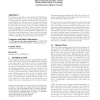NETGAMES
2006
ACM
14 years 5 months ago
2006
ACM
While psychologists analyze network game-playing behavior in terms of players’ social interaction and experience, understanding user behavior is equally important to network res...
NETGAMES
2006
ACM
14 years 5 months ago
2006
ACM
We present an approach to support Massively Multiplayer Online Role-Playing Games. Our proposed solution begins by splitting the large virtual world into smaller regions, each reg...
NETGAMES
2006
ACM
14 years 5 months ago
2006
ACM
Massive Multiplayer Online Games with their virtual gaming worlds grow in user numbers as well as in the size of the virtual worlds. With this growth comes a significant increase...
NETGAMES
2006
ACM
14 years 5 months ago
2006
ACM
Multiplayer gaming over the Internet continues to grow in popularity, despite a lack of Quality of Service (QoS) mechanisms. Future QoS-aware networks such as those based on the D...
NETGAMES
2006
ACM
14 years 5 months ago
2006
ACM
This paper studies a way to improve consistency of states in a ball game typed DVE with lag, in P2P architecture. We also study how to control shared objects in real-time in a ser...
NETGAMES
2006
ACM
14 years 5 months ago
2006
ACM
While massively multiplayer on-line games (MMOs) are enormously popular, their use of the client-server architecture causes them to suffer from scalability issues and high mainte...
NETGAMES
2006
ACM
14 years 5 months ago
2006
ACM
Synchronization protocols based on “dead-reckoning” are vulnerable to a popular type of cheat called speed-hack. A speed-hack helps a cheater to gain unfair advantages by essen...
NETGAMES
2006
ACM
14 years 5 months ago
2006
ACM
This paper presents our ongoing research activity to design and implement a framework for an networked virtual environment (NVE) that efficiently supports both hardware and softwa...
NETGAMES
2006
ACM
14 years 5 months ago
2006
ACM
Pervasive games provide a new type of game combining new technologies with the real environment of the players. While this already poses new challenges to the game developer, requ...
NETGAMES
2006
ACM
14 years 5 months ago
2006
ACM
Multi-player Online Games (MOGs) have emerged as popular data intensive applications in recent years. Being used by many players simultaneously, they require a high degree of faul...




